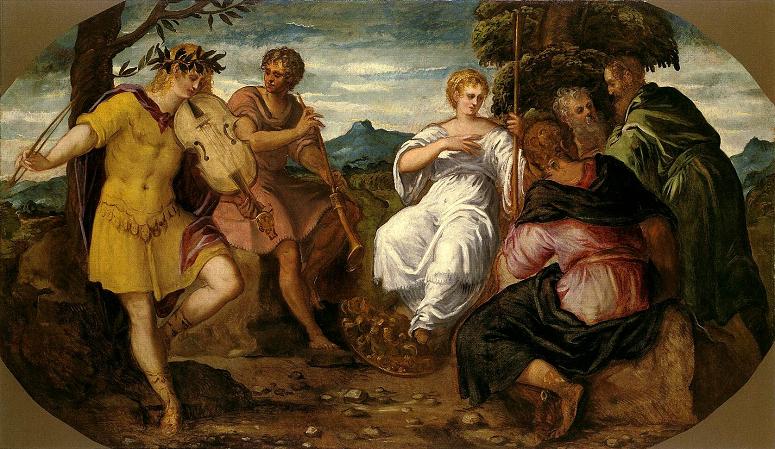Apollo Belvedere (130). Marble. 225. The Apollo Belvedere is a celebrated marble sculpture from Classical Antiquity. The Apollo is now thought to be an original Roman re-creation of Hadrianic date. The distinctively Roman foot-wear is one reason scholars believe it is not a copy of an original Greek statue. It was rediscovered in central Italy in the late 15th century during the Italian Renaissance and was placed on semi-public display in the Vatican Palace in 1511, where it remains. It is now in the Cortile del Belvedere of the Pio-Clementine Museum of the Vatican Museums complex. From the mid-18th century it was considered the greatest ancient sculpture by ardent neoclassicists, and for centuries it epitomized the ideals of aesthetic perfection for Europeans and westernized parts of the world. The Greek god Apollo is depicted as a standing archer having just shot an arrow. Although there is no agreement as to the precise narrative detail being depicted, the conventional view has been that he has just slain the serpent Python, the chthonic serpent guarding Delphi, making the sculpture a Pythian Apollo. Alternatively, it may be the slaying of the giant Tityos, who threatened his mother Leto, or the episode of the Niobids. The large white marble sculpture is 2.24 m high. Its complex contrapposto has been much admired, appearing to position the figure both frontally and in profile. The arrow has just left Apollo's bow and the effort impressed on his musculature still lingers. His hair, lightly curled, flows in ringlets down his neck and rises gracefully to the summit of his head, which is encircled with the strophium, a band symbolic of gods and kings. His quiver is suspended across his left shoulder. He is entirely nude except for his sandals and a robe clasped at his right shoulder, turned up on his left arm, and thrown back. The lower part of the right arm and the left hand were missing when discovered and were restored by Giovanni Angelo Montorsoli, a sculptor and pupil of Michelangelo. Before its installation in the Cortile delle Statue of the Belvedere palace in the Vatican, the Apollo, which seems to have been discovered in 1489 in the present territory of Anzio, or perhaps at Grottaferrata where Giuliano della Rovere was abbot in commendam, apparently received very little notice from artists. It was, however, sketched twice during the last decade of the 15th century in the book of drawings by a pupil of Domenico Ghirlandaio, now at the Escorial. Though it has always been known to have belonged to Giuliano della Rovere before he became pope, as Julius II, its placement has been confused until as recently as 1986: Cardinal della Rovere, who held the titulus of San Pietro in Vincoli, stayed away from Rome for the decade during Alexander VI's papacy; in the interim, the Apollo stood in his garden at SS. Apostoli, Deborah Brown has shown, and not at his titular church, as had been assumed. Once it was installed in the Cortile, however, it immediately became famous in artistic circles and a demand for copies of it arose. The Mantuan sculptor Pier Jacopo Alari Bonacolsi, called L'Antico, made a careful wax model of it, which he cast in bronze, finely finished and partly gilded, to figure in the Gonzaga collection, and in further copies in a handful of others. Albrecht Durer reversed the Apollo's pose for his Adam in a 1504 engraving of Adam and Eve, suggesting that he saw it in Rome. When L'Antico and Durer saw it, the Apollo was probably still in the personal collection of della Rovere, who, once he was pope as Julius II, transferred the prize in 1511 to the small sculpture court of the Belvedere, the palazzetto or summerhouse that was linked to the Vatican Palace by Bramante's large Cortile del Belvedere. It became the Apollo of the Cortile del Belvedere, and the name has remained with it, though the sculpture has long been indoors, in the Museo Pio-Clementino at the Vatican Museums, Rome. In addition to Durer, several major artists during the late Renaissance sketched the Apollo, including Michelangelo, Bandinelli, and Goltzius. In the 1530s it was engraved by Marcantonio Raimondi, whose printed image transmitted the famous pose throughout Europe. The Apollo became one of the world's most celebrated art works when in 1755 it was championed by the German art historian and archaeologist Johann Joachim Winckelmann as the best example of the perfection of the Greek aesthetic ideal. Its noble simplicity and quiet grandeur, as he described it, became one of the leading lights of neo-classicism and an icon of the Enlightenment. Goethe, Schiller and Byron all endorsed it.
more...







